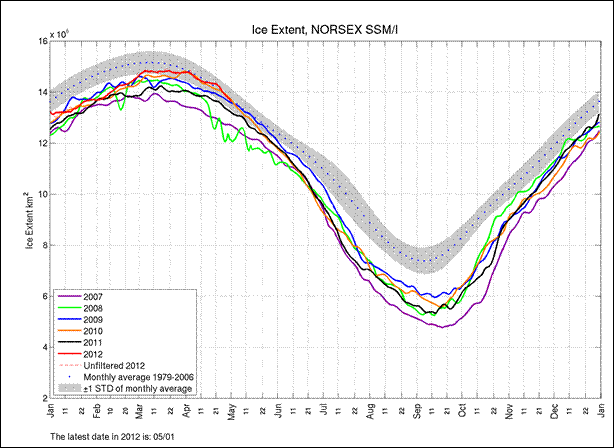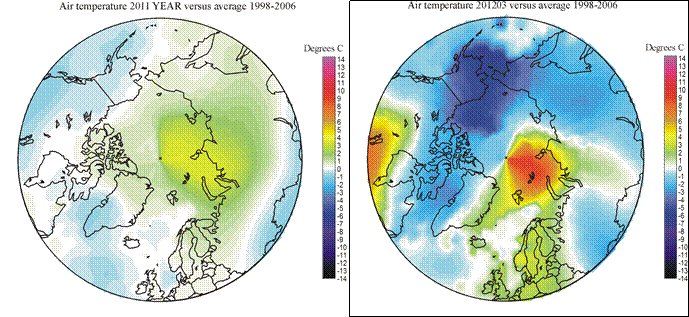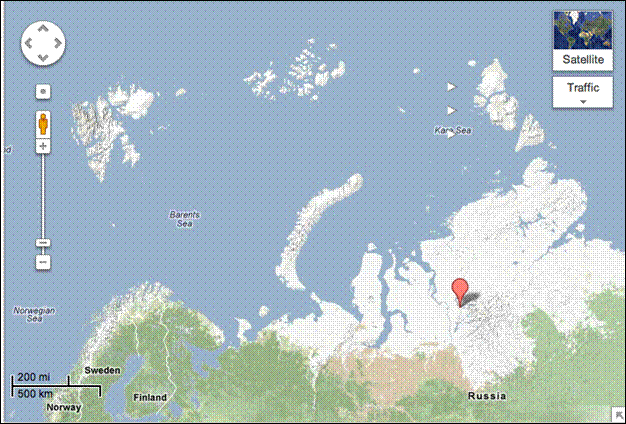S ulfur Dioxide and Arctic Warming
ulfur Dioxide and Arctic Warming
By Ed Caryl
Sulfur dioxide, SO2, is not a greenhouse gas. But it should not be ignored when discussing climate. We know that the SO2 injected into the stratosphere by large volcanoes such as Agung, El Chichon, and Pinatubo, can cause cooling for a period of years. This is because of the reflective haze created by SO2 combining with water vapor to create sulphuric acid aerosol that then takes two or three years to fall down to altitudes where they find enough water vapor to grow, form clouds, and rain out.
We know that SO2 from industry and fossil fueled power plants form smogs and low clouds that produce acid rain down wind from the sources. We know what damage acid rain can do when the acid content is high enough to harm plant life. But little attention has been paid to the climate effects of the smogs themselves.
We know that low clouds and fogs keep surface temperatures from falling at night, as well as keeping surface temperatures from rising during daylight.
We know that in the polar regions in winter it is night all the time.
Now put those things together. In the Arctic, in winter, smogs and low clouds caused by SO2 will trap heat below them 24 hours a day, and in the spring will prevent sunlight from reaching and warming the surface. On the Arctic Ocean, this will delay both freezing in the winter and melting in the spring.
Figure 1: NORSEX ice extent for the last five years plus 2012 to date.
We can see clearly that the freeze-up in the Arctic has been delayed in recent years compared to the 1979 to 2006 average. Because the freeze-up is delayed, there is less ice to thaw in the spring, so that delay is less obvious, except that the ice minimum is also delayed compared to the average. Now we get to why? First, we look at two temperature anomaly maps of the Arctic.
Figure 2a and 2b: Temperature anomaly maps from Climate4You of the Arctic for all of 2011 and March of 2012. Note the location of the warming.
Now another map. This is a map of northern Russia.
Figure 3: Google map of northern Russia. The indicator on the map is the location of Norilsk.
Norilsk is the location of the world’s largest nickel mine. They also recover copper, cobalt, platinum, and palladium. Nearby, coal is mined to support the power needs of the city (130,000 population), the mine, and the smelter operations. SO2 emissions are about one million metric tons per year. This one location is responsible for 1% of all the SO2 emissions in the world, 10% of all of Europe’s emissions.
CNN reports that there is not a single living tree within 48 kilometers (30 miles) of the nickel smelter. 2,832 square kilometers (1093 square miles) of forest have been killed, and another 5371 square kilometers (2073 square miles) have been damaged. For a full report on the damage read this pdf document.
Norilsk Mining has other smelters on the Kola Peninsula very close to the Norwegian border. They also emit large amounts of SO2. Both locations are well above the Arctic Circle. All these emissions are within a very sensitive part of the Earth: the Arctic.
During the winter, the winds in the Arctic are variable, depending on the position of the Arctic front. The winds alternate between blowing to and from the land, moving any pollution over the Arctic Ocean or inland. In Figure 2b, in March,
the pollution from Norilsk was moving over the ocean much of the time. You can see the ebb and flow of the winds as they moved the sea ice in an animation of the last year here (from NRL).
Normally, SO2 is not a greenhouse gas, but it is in the dark of winter in the Arctic. In combination with water vapor, which is a greenhouse gas, it produces smog and low clouds that reflect heat back to the surface when it is dark, and upward into space when the sun shines. This distorts the melting and freezing patterns resulting in less ice in the Arctic Ocean. Yes, the reduction in ice in the Arctic is anthropogenic, with a Russian accent.
One thing people don’t know is that the platinum/palladium used in in automotive catalytic converters comes from Norilsk. We are simply moving the pollution from a distributed source, automobiles, to a concentrated source in Siberia. We are all responsible for Arctic warming.
Postscript: Norilsk Mining plans to reduce SO2 emissions by two-thirds as soon as they develop the necessary technology. They think this can be done by 2015 or 2020. Just in time for the general global cooling.








It is more the sea rather than any Russian sulfur dioxide that has a pronounced impact on the air temperature in the Arctic particularly during the winter season. This would be much clearer if the colossal Artic warming since winter 1919 (for two decades) could be thoroughly explained by now. Bengtsson et al (2004) actually offered little more than that: “natural variability is the likely cause”; while Johannessen et al (2004) regarded the observations (1920 to the 1970) as “due to natural fluctuations internal to the climate system”, although Brooks noted 75 years ago: “Whatever the mechanism, the rise of temperature did begin and presumably had a cause” (Brooks, 1938), which definitely had nothing to do with Russian sulphur dioxide. For more on the Artic warming 1919 to 1939, see the discussion at: http://www.arctic-heats-up.com/
http://www.arctic-warming.com/
Regards
Yes, the currents into the Arctic cycle. But the current cycle has been aided by pollution in the arctic. Norilsk is putting 1,000,000 tons of SO2 into the environment every year. This the equivalent of one Pinatubo every 19 years. This has been done for the last 75 years. You can’t dismiss it.
Great find, Ed!
SO2 does have IR absorption lines, strongest at wavenumber 1350 (periods per cm). That should be a wavelength of 7.4 micrometer.
http://webbook.nist.gov/cgi/cbook.cgi?ID=7446-09-5&Type=IR-SPEC&Index=QUANT-IR,8#IR-SPEC
CO2 absorbs at 4.3 and 14 micrometer.
http://www.wag.caltech.edu/home/jang/genchem/infrared.htm
I find this on yahoo answers (I don’t give a link because I land in the spam bin for 3 or more links) re the question “Why is SO2 not a GHG?”
“That’s because, in our atmosphere, it’s rapidly oxidized, and falls out as small particles called “sulfates”. The total effect is actually to cause a small cooling. It was important in keeping temperatures constant from 1950-1970 or so, because we emitted a lot of it then.”
So, the reason climate alarmists do not ring the alarm bells over SO2 is its short residence time, and its aerosolic cooling effect, but as Norilsk constantly replenishes the stuff, the residence time argument doesn’t apply here, and as you argued, the aerosolic cooling effect doesn’t apply in the polar winter. So in that special case the IR absorption and re-emission by SO2 might play a role!
I thought it might, but I couldn’t find a paper to back up the idea.
Just asking Google complete questions works wonderfully because the search engine has so much context to chew on. Try a search like
“What is the IR absorption spectrum of SO2”
(omit the quotes)
It feels silly to talk to a machine but it works.
Did Google buy Watson?
Thank you, Dirk. I found more data. Another article coming.
Maybe they have parsers for some simple question structures. They do have special parsers for unit conversions; try entering
1 liter in gallons
We programmers love to do such trickery.
“Postscript: Norilsk Mining plans to reduce SO2 emissions by two-thirds as soon as they develop the necessary technology.”
Hasn’t such technology been available for about 25 years or more? And are there not technology-transfer arrangements under UN and other inter-govt. treaties?
From the following link about Sudbury, the superstack, and scrubbing “waste” gases:
http://en.wikipedia.org/wiki/Inco_Superstack
The world is awash in money for bashing entrepreneurs and others that do not adhere to the progressive/green agenda. Perhaps providing technological improvements at Norilsk could be worked into there schedule. Maybe a few thousand such folks could trek up there and spend the next winter protesting. Tell them to take coats and hats.
It’s a closed city. No foreigners allowed. (Unless you are from Belarus.)
Ed,
I don’t get it. SO2 is responsible for global cooling when it is injected into the atmosphere by volcanoes. However you suggest that SO2 emitted by industrial plants in Norilsk is responsible for local warming in the Arctic. Have you seen the location near Norilsk via Google Earth? The snow is dark, because it is covered by the dust belched through the chimneys! The dark snow adsorbs IR, and therefore it’s getting warmer.
SO2 belched into the stratosphere by volcanoes cause cooling by oxidizing and forming Sulphuric acid droplets which reflect light, increasing albedo, reflecting sunlight upward. In the Arctic, the energy that is reflected is that coming up from below, from the ocean (and in winter, the ice) reflecting the warmth back down. The dark snow just adds to the warming. The SO2 smog over that dark surface just adds even more warming. Thank you for that observation. It adds to my point.
Arctic climate research has a huge advantage, compared more southern regions, as there is a long sunless period, which should help to identify the possible reason of short- and long term variation. The seasonal difference should be in focus.
With regard to the notion: “SO2 belched into the stratosphere by volcanoes..” , the Krakatoa eruption (August 1883), did not generated immediately a decrease of temperatures. The atmospheric circulation in 1884 was above normal and did not sink to a strongly developed winter minimum in continental regions until 1888. The influence of the oceans was shown clearly by the fact that coastal areas had above-average temperatures in 1884, whereas continental land masses such as Russia, Siberia, India, China, Canada, and the USA (inland areas far from the Atlantic) recorded very cold winters in the years up to 1888.
Discussed in a paper from 1992, available at: http://www.whatisclimate.com/conditions-for-the-protection-of-the-global-climate.html#_aa12